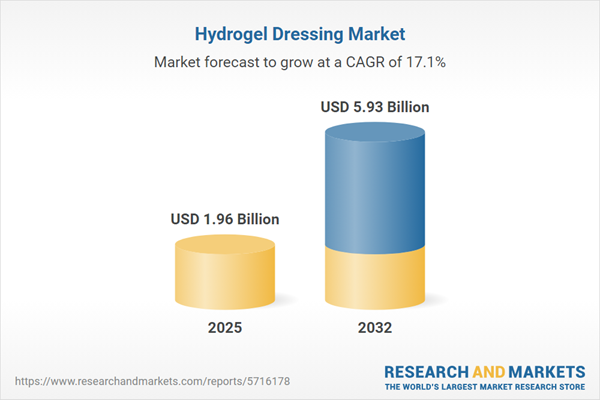Speak directly to the analyst to clarify any post sales queries you may have.
The hydrogel dressing market is rapidly redefining standards for advanced wound care, driven by ongoing innovation and changing clinical and regulatory landscapes. As focus intensifies on patient-centric outcomes and smarter medical materials, businesses in this space are poised for significant opportunities and challenges.
Market Snapshot: Strong Growth Trajectory for Hydrogel Dressing Market
The hydrogel dressing market progressed from USD 1.67 billion in 2024 to USD 1.96 billion in 2025, with expectations of continued expansion at a robust CAGR of 17.12%. By 2032, the global market is projected to reach USD 5.93 billion. This trajectory reflects sustained momentum driven by the integration of novel wound management solutions, regulatory changes, and increased investment in research and development.
Scope & Segmentation of the Hydrogel Dressing Market
This comprehensive report evaluates the hydrogel dressing market according to application, product type, end user, distribution channel, region, and key market participants.
- Applications: Acute wounds, burns (chemical, radiation, thermal), chronic wounds (diabetic ulcers, pressure ulcers, venous ulcers), surgical wounds (cardiovascular, general surgery, orthopedic).
- Product Types: Amorphous hydrogel, impregnated gauze hydrogel, spray hydrogel, thin sheet hydrogel.
- End Users: Ambulatory surgical centers, home care (professional care, self care), hospitals, specialized wound care centers.
- Distribution Channels: Direct sales, hospital pharmacies, online channels (e-commerce marketplaces, manufacturer websites), retail pharmacies, third-party distributors.
- Regions: Americas (North America, Latin America), Europe, Middle East & Africa, Asia-Pacific. Leading countries include United States, Canada, Brazil, United Kingdom, Germany, China, India, Japan, and Australia.
- Key Companies: Smith & Nephew plc, 3M Company, ConvaTec Group PLC, Coloplast A/S, Mölnlycke Health Care AB, Johnson & Johnson Services, Inc., Integra LifeSciences Corporation, BSN medical GmbH, Medline Industries L.P., Hollister Incorporated.
Key Takeaways for Senior Decision-Makers
- Hydrogel dressings are integral to advanced wound management due to their unique combination of moisture retention, comfort, and compatibility with tissue healing protocols.
- Emerging hydrogel technologies incorporate nanocomposites and stimuli-responsive materials, enhancing antimicrobial functions and enabling targeted growth factor delivery.
- Partnerships between clinical institutions, academic centers, and manufacturers have accelerated the translation of laboratory research into market-ready products.
- Markets such as the Americas drive adoption with well-established reimbursement frameworks, while Asia-Pacific demonstrates increasing demand linked to rising chronic wound incidence and healthcare investment.
- Sustainability is influencing material choices, with several manufacturers developing biodegradable, eco-friendly hydrogel variants to address environmental priorities.
- Digital health integration, including sensor-enabled hydrogel dressings, is improving care monitoring and facilitating personalized interventions.
Tariff Impact: Navigating Supply Chain Disruption and Cost Structures
The 2025 introduction of U.S. tariffs on hydrogel materials significantly affected supplier strategies, procurement models, and overall production costs. Companies responded by diversifying sources, pursuing regional partnerships, and implementing value engineering to optimize product formulation while maintaining efficacy. These shifts underscore the importance of resilient, agile supply chain management within the hydrogel dressing industry.
Methodology & Data Sources
The report employs a multi-faceted research approach, blending qualitative interviews with wound care experts and material scientists, and rigorous secondary analysis of industry literature, regulatory datasets, and patent filings. Data triangulation and expert validation underpin all findings, ensuring analytical accuracy and relevance.
Why This Report Matters
- Enables senior leaders to anticipate market shifts and support data-driven decisions for portfolio expansion and risk mitigation.
- Offers granular insight into regulatory, technological, and competitive developments shaping both global and regional hydrogel dressing adoption.
- Assists procurement and supply chain strategists in anticipating and responding to market challenges, including tariff impacts and sustainability mandates.
Conclusion
With convergence across regenerative medicine, digital health, and regulatory innovation, the hydrogel dressing market is on a dynamic path. Decision-makers equipped with this analysis can identify the most promising growth avenues and proactively respond to evolving market and clinical needs.
Additional Product Information:
- Purchase of this report includes 1 year online access with quarterly updates.
- This report can be updated on request. Please contact our Customer Experience team using the Ask a Question widget on our website.
Table of Contents
3. Executive Summary
4. Market Overview
7. Cumulative Impact of Artificial Intelligence 2025
Companies Mentioned
The companies profiled in this Hydrogel Dressing market report include:- Smith & Nephew plc
- 3M Company
- ConvaTec Group PLC
- Coloplast A/S
- Mölnlycke Health Care AB
- Johnson & Johnson Services, Inc.
- Integra LifeSciences Corporation
- BSN medical GmbH
- Medline Industries, L.P.
- Hollister Incorporated
Table Information
| Report Attribute | Details |
|---|---|
| No. of Pages | 191 |
| Published | October 2025 |
| Forecast Period | 2025 - 2032 |
| Estimated Market Value ( USD | $ 1.96 Billion |
| Forecasted Market Value ( USD | $ 5.93 Billion |
| Compound Annual Growth Rate | 17.1% |
| Regions Covered | Global |
| No. of Companies Mentioned | 11 |









